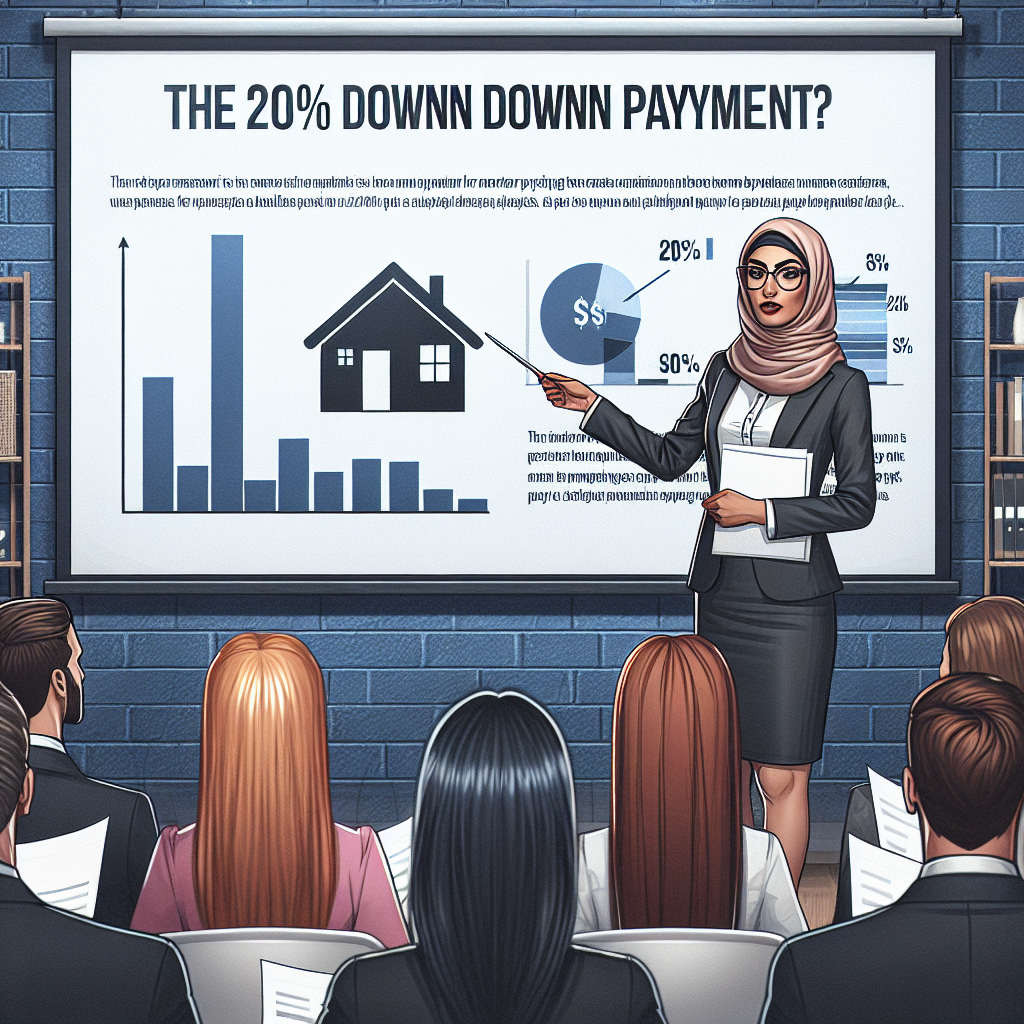-
Table of Contents
- Analyst Debunks 20% Down Payment Myth: Here’s What Homebuyers Are Actually Paying
- The Origin of the 20% Down Payment Myth
- Current Down Payment Trends
- Case Studies: Real-World Examples
- Case Study 1: First-Time Homebuyer in California
- Case Study 2: Veteran Homebuyer in Texas
- Case Study 3: Rural Homebuyer in Ohio
- Loan Programs with Low Down Payment Options
- The Role of Private Mortgage Insurance (PMI)
- Down Payment Assistance Programs
- Benefits of Lower Down Payments
- Challenges and Considerations
- Conclusion
Analyst Debunks 20% Down Payment Myth: Here’s What Homebuyers Are Actually Paying

For decades, the notion that prospective homebuyers need to save up a 20% down payment has been a widely accepted standard. However, recent analyses and market trends suggest that this long-held belief may no longer hold true. In this article, we will explore the evolving landscape of down payments, debunk the 20% myth, and provide insights into what homebuyers are actually paying today.
The Origin of the 20% Down Payment Myth
The 20% down payment rule has its roots in traditional mortgage lending practices. Historically, lenders required a substantial down payment to mitigate their risk. A 20% down payment reduced the loan-to-value (LTV) ratio, making it less likely that the lender would lose money if the borrower defaulted. Additionally, a larger down payment demonstrated the borrower’s financial stability and commitment to the property.
However, the housing market and lending landscape have evolved significantly over the years. Today, various loan programs and financial products offer more flexibility, making homeownership accessible to a broader range of buyers.
Current Down Payment Trends
Recent data and studies reveal that the average down payment for homebuyers is significantly lower than 20%. According to the National Association of Realtors (NAR), the median down payment for all homebuyers in 2022 was just 13%. For first-time homebuyers, the median down payment was even lower, at 7%.
Several factors contribute to this trend:
- Rising Home Prices: As home prices continue to climb, saving 20% of the purchase price becomes increasingly challenging for many buyers.
- Low-Down-Payment Loan Programs: Various loan programs, such as FHA loans, VA loans, and USDA loans, allow for down payments as low as 3.5%, 0%, and 0%, respectively.
- Private Mortgage Insurance (PMI): PMI allows buyers to secure a mortgage with a lower down payment by paying an additional monthly premium.
- Gift Funds and Assistance Programs: Many buyers receive financial assistance from family members or take advantage of down payment assistance programs offered by state and local governments.
Case Studies: Real-World Examples
To illustrate the shift in down payment trends, let’s examine a few real-world examples:
Case Study 1: First-Time Homebuyer in California
Jane, a first-time homebuyer in California, purchased a $500,000 home with a 5% down payment. She utilized an FHA loan, which required a 3.5% down payment, and covered the remaining 1.5% with savings and a gift from her parents. Jane’s total down payment was $25,000, far below the traditional 20% ($100,000).
Case Study 2: Veteran Homebuyer in Texas
John, a veteran, bought a $300,000 home in Texas using a VA loan. VA loans offer 100% financing, meaning John did not need to make a down payment. Instead, he focused on covering closing costs and other expenses associated with the purchase.
Case Study 3: Rural Homebuyer in Ohio
Emily, a homebuyer in rural Ohio, took advantage of a USDA loan to purchase a $200,000 home. USDA loans also offer 100% financing, allowing Emily to buy her home without a down payment. She used her savings to cover closing costs and moving expenses.
Loan Programs with Low Down Payment Options
Several loan programs cater to buyers who cannot afford a 20% down payment. These programs have specific eligibility requirements and benefits:
- FHA Loans: Backed by the Federal Housing Administration, FHA loans require a minimum down payment of 3.5%. They are popular among first-time homebuyers and those with lower credit scores.
- VA Loans: Available to veterans, active-duty service members, and eligible surviving spouses, VA loans offer 100% financing with no down payment required. They also come with competitive interest rates and no PMI.
- USDA Loans: Designed for rural and suburban homebuyers, USDA loans provide 100% financing with no down payment. They are backed by the U.S. Department of Agriculture and have income and property location requirements.
- Conventional Loans with PMI: Conventional loans can be obtained with as little as 3% down. However, buyers who put down less than 20% are typically required to pay PMI, which protects the lender in case of default.
The Role of Private Mortgage Insurance (PMI)
Private Mortgage Insurance (PMI) plays a crucial role in enabling buyers to purchase homes with lower down payments. PMI is an insurance policy that protects the lender if the borrower defaults on the loan. It is typically required for conventional loans with down payments of less than 20%.
While PMI adds an additional cost to the monthly mortgage payment, it allows buyers to enter the housing market sooner rather than waiting to save a larger down payment. Once the borrower reaches 20% equity in the home, they can request to have PMI removed, reducing their monthly payment.
Down Payment Assistance Programs
Many state and local governments, as well as non-profit organizations, offer down payment assistance programs to help buyers cover the cost of their down payment and closing costs. These programs can take various forms, including grants, forgivable loans, and deferred payment loans.
For example, the California Housing Finance Agency (CalHFA) offers the MyHome Assistance Program, which provides a deferred-payment junior loan of up to 3.5% of the purchase price or appraised value, whichever is less. This assistance can be used for down payment and/or closing costs.
Similarly, the Texas State Affordable Housing Corporation (TSAHC) offers the Homes for Texas Heroes and Home Sweet Texas Home Loan Programs, which provide down payment assistance in the form of grants or second liens.
Benefits of Lower Down Payments
Lower down payments offer several benefits to homebuyers:
- Increased Accessibility: Lower down payments make homeownership more accessible to a broader range of buyers, including those with limited savings or lower incomes.
- Preservation of Savings: Buyers can preserve their savings for other expenses, such as home improvements, emergency funds, or retirement savings.
- Faster Entry into the Market: Buyers can enter the housing market sooner, potentially benefiting from property appreciation and building equity over time.
Challenges and Considerations
While lower down payments offer many advantages, they also come with certain challenges and considerations:
- Higher Monthly Payments: Lower down payments result in higher loan amounts, leading to higher monthly mortgage payments.
- PMI Costs: Buyers with down payments of less than 20% typically need to pay PMI, which adds to their monthly expenses.
- Equity Building: With a smaller initial equity stake, it may take longer for buyers to build significant equity in their homes.
Conclusion
The 20% down payment myth is increasingly being debunked as more homebuyers take advantage of low-down-payment loan programs, PMI, and down payment assistance. The median down payment for homebuyers today is significantly lower than 20%, making homeownership more accessible to a broader range of individuals.
While lower down payments come with certain challenges, they offer numerous benefits, including increased accessibility, preservation of savings, and faster entry into the housing market. By understanding the various options available and carefully considering their financial situation, prospective homebuyers can make informed decisions that align with their goals and circumstances.
In summary, the evolving landscape of down payments reflects a more inclusive and flexible approach to homeownership. As buyers continue to navigate this dynamic market, it is essential to stay informed about the latest trends and opportunities to make the best possible choices for their future.








